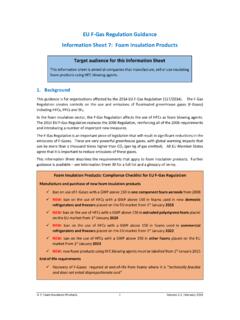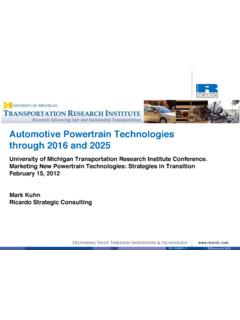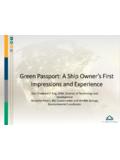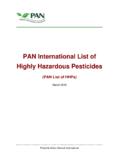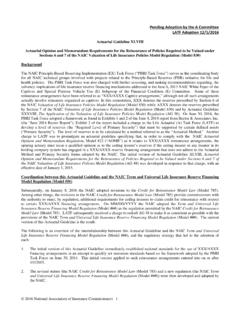Transcription of EU F-Gas Regulation Guidance Information Sheet 14 ...
1 EU F-Gas Regulation Guidance Information Sheet 14: refrigeration , Air- conditioning and heat Pump Contractors Target audience for this Information Sheet This Information Sheet is aimed at contractors that carry out installation, maintenance and decommissioning work on refrigeration , air- conditioning and heat pump systems (RACHP). It is also useful for operators of RACHP systems that use 3rd party contractors to maintain their plant. 1. Background This Guidance is for organisations affected by the 2014 EU F-Gas Regulation (517/ 2014 ). The F-Gas Regulation creates controls on the use and emissions of fluorinated greenhouse gases (F-Gases). including HFCs, PFCs and SF6. Contractors play a major role supporting operators of refrigeration , air- conditioning and heat pump (RACHP) equipment. They have to comply with a number of requirements under the F-Gas Regulation . The 2014 EU F-Gas Regulation replaces the 2006 Regulation , strengthening all of the 2006. requirements and introducing a number of important new measures.
2 The F-Gas Regulation is an important piece of legislation that will result in significant reductions in the emissions of F-Gases. These are very powerful greenhouse gases, with global warming impacts that are several thousand times higher than CO2 (per kg of gas emitted). All EU Member States agree that it is important to reduce emissions of these gases. This Information Sheet describes the requirements that apply to RACHP contractors. Further Guidance is available see Information Sheet 30 for a full list and a glossary of terms. RACHP Contractors: Compliance Checklist for EU F-Gas Regulation NEW: Advise customers about the impact of HFC bans, the service ban and the phase down on the selection of refrigerants for new equipment Ensure the company and all relevant staff have suitable F-Gas training and certification NEW: Comply with new legal responsibility on contractors to prevent leaks Ensure new plants are properly labelled during installation NEW: Ensure mandatory leak checks and repairs are carried out, using the new CO2.
3 Equivalent size thresholds for leak checks and for automatic leak detection NEW: Ensure appropriate records are kept by both contractor and operator NEW: Advise operators to make early preparations for the service ban NEW: changes to requirements to purchase of refrigerants and pre-charged equipment Ensure proper recovery of refrigerant during maintenance and at end-of-life IS 14: RACHP Contractors 1 Version , December 2014 . EU F-Gas Regulation Guidance 2. Sector description The RACHP sector covers a wide range of equipment and end users, ranging from small domestic and commercial systems to large industrial plant. Key sectors of the RACHP market include 1. Domestic refrigeration 2. Commercial refrigeration 3. Industrial refrigeration 4. Transport refrigeration 5. Stationary air- conditioning and heat pumps 6. Mobile air- conditioning Detailed Guidance on the impact of the 2014 F-Gas Regulation on each of these sectors is available in Information Sheets 1 to 6. Most operators of RACHP equipment in these sectors make use of specialist contractors for installation and maintenance work.
4 There are over 5,000 RACHP contractors in the UK, ranging from large companies with UK-wide capability to very small businesses working in a small geographic area. The skill and expertise of the RACHP contracting industry is crucial, providing operators with various services through the life cycle of RACHP equipment. The F-Gas Regulation places legally binding obligations on contractors to ensure that they help end users minimise the use and emissions of high GWP1 refrigerants. It is important that contractors comply with the regulations that apply to them and also that they are aware of other relevant parts of the F-Gas Regulation so that they can provide their clients with appropriate advice. 3. Advice regarding purchase of new equipment Contractors often provide important advice to their clients about purchase of new equipment. In the 2014 F-Gas Regulation there are 3 important new requirements that will change the advice that contractors give to their clients. These are: a) Various specific bans, that will require lower GWP refrigerants to be used b) The impact of the HFC phase down, that will encourage use of low GWP refrigerants c) The impact of the service ban, which affects the purchase of new systems using high GWP.
5 Refrigerants such as HFC 404A. NEW: HFC Bans The 2014 Regulation includes a number of HFC bans as summarised in Table 1. Contractors should be aware that these bans do not tell the full story . You must make clients aware of the phase down and the service ban (see below) these also have a significant influence on selecting new plant. NEW: Impact of the Service Ban on purchase of new equipment Purchasers of new commercial and industrial refrigeration equipment must be aware that a Service Ban will affect certain existing systems using HFCs with a GWP above 2,500 from 2020. The ban applies to systems containing more than 40 tonnes CO2 equivalent (10 kg for HFC 404A). To avoid future problems you should advise clients purchasing plants above this size threshold to select only 1. GWP, Global Warming Potential: see Information Sheet 25 for details about GWP. IS 14: RACHP Contractors 2 Version , December 2014 . EU F-Gas Regulation Guidance refrigerants with a GWP below 2,500, with immediate effect.
6 The service ban is discussed in more detail in Section 7, below. NEW: Impact of the HFC Phase Down on the purchase of new equipment When purchasing new RACHP equipment your clients should also consider the HFC phase down2. This will reduce the quantity of HFCs that can be sold in the EU by 2030 there will be an 80% cut in HFC. supply. Equipment bought now will still be operating when deep cuts in HFC supply are in force. Irrespective of the bans described above, it makes sense to always purchase equipment using refrigerants with the lowest practical GWP to minimise the future impact of the phase down3. Table 1: Bans affecting RACHP Equipment Market Sector Product Description Scope of banned F-Gases Start Date4. Non-confined direct evaporation systems All HFCs and PFCs 2007. Domestic refrigerators and freezers5 HFCs with GWP > 150 2015. Refrigerators and freezers for commercial use HFCs with GWP > 2,500 2020. refrigeration (hermetically sealed)6. HFCs with GWP > 150 2022. All stationary refrigeration equipment7 HFCs with GWP > 2,500 2020.
7 Multipack central systems for commercial use8 F-Gases with GWP > 150 2022. Air- Moveable, hermetically sealed air- conditioning HFCs with GWP > 150 2020. conditioning Single split systems containing 3 kg or less F-Gases with GWP >750 2025. 4. contractor training and certification requirements All refrigerant handling operations on RACHP equipment containing HFC refrigerants must be carried out by suitably trained technicians holding an F-Gas handling certificate and working for an F-Gas certificated company. This includes plant installation, leak testing, refrigerant recovery, maintenance and end-of-life decommissioning. The training and certification requirements are based on those already specified in the 2006 F-Gas Regulation . Existing individual F Gas qualification certificates remain valid in accordance with the conditions under which they were originally issued. This means that those who hold certificates with an expiry date (CITB J11-J14) will need to be re-assessed and an updated assessment is now available.
8 2. HFC phase down: see Information Sheet 28 for further details 3. Low GWP alternatives to HFCs: see Information Sheet 29 for further details 4. All start dates are January 1st of year specified 5. This ban includes both refrigerant and foam blowing agent 6. This ban includes both refrigerant and foam blowing agent 7. Exemption for equipment cooling products below -50oC. 8. The primary circuit of cascade systems can use an HFC with a GWP up to 1,500. IS 14: RACHP Contractors 3 Version , December 2014 . EU F-Gas Regulation Guidance NEW: The certification requirements have been extended to include technicians working on refrigerated trucks (> tonnes) and refrigerated trailers. NEW: Qualified technicians must also be given Information on relevant technologies to replace or to reduce the use of fluorinated greenhouse gases and their safe handling . No further assessments are required, but all technicians should be aware of relevant Information about the use of alternatives. It is expected that standard Information will be prepared and then circulated via Certification Bodies.
9 Company Certification is required by all contractors carrying out installation and maintenance work. This applies to sole traders as well as limited companies. The process is unchanged from the 2006. Regulation . Defra has designated three bodies that can issue an RACHP Company Certificate: Refcom, Bureau Veritas and Quidos. See Information Sheet 21 for details of all RACHP training and certification requirements. 5. contractor responsibilities to minimise refrigerant emissions Under the 2006 F-Gas Regulation the legal responsibilities related to F-Gas emissions from RACHP. equipment were held only by the plant operator (usually the owner). NEW: In the 2014 Regulation there is an explicit legal requirement for contractors to share this responsibility. Article 3 of the Regulation states that The intentional release of F-Gases into the atmosphere shall be prohibited where the release is not technically necessary for the intended use.. The Regulation then states that contractors carrying out the installation, servicing, maintenance, repair or decommissioning of RACHP equipment shall be certified and shall take precautionary measures to prevent leakage of F-Gases.
10 This is an important new requirement about which contractors may need to inform a client, if they are being asked to do something that does not comply with the Regulation . 6. contractor responsibilities during plant installation All contractor staff carrying out installation work related to refrigerant handling must hold the appropriate F-Gas handling certificate and must make precautionary measures to prevent leakage. Engineers carrying out unrelated installation activities ( electrical work) do not need a refrigerant handling qualification. However, anyone doing work that could affect the refrigerant circuit and give rise to possible leakage must be qualified an engineer setting a high pressure cut-out device should be qualified if this was set incorrectly it could give rise to a leak. Product Labelling All RACHP products that contain F-Gases (including HFCs) shall not be placed on the market unless the F-Gases are identified with a label. The label shall indicate the following Information : 1) A reference that the RACHP system contains F-Gases 2) The accepted industry designation for the F-Gas concerned or, if no such designation is available, the chemical name 3) NEW: From 1 January 2017, the quantity expressed in weight and in CO2 equivalent of F-Gas contained in the equipment, and the global warming potential of the gas 4) If applicable, a reference that the F-Gases are contained in hermetically sealed equipment IS 14: RACHP Contractors 4 Version , December 2014 .


